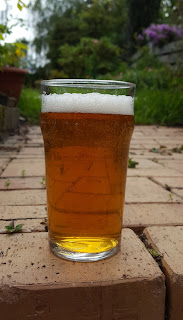Is it possible to make a bottled IPA that’s drinkable ten days after brewing? On the evidence of this experiment, the answer is, Yes! … just about.
Holiday plans have been all over the place with COVID restrictions, but we were on Skype with my parents in May and made the decision to meet up at the start of June. I said I’d bring some beers. Then I looked in my diary and realised that was rash. We’d be going away in ten days. Still, worth a try I thought.
The plan was for a light IPA, cloudy (so not too much clearing required) and hop forward. In fact, freshness is a virtue with this style, so it seemed perfect. Here is the recipe I used, for a 50L batch:
Grains:
9.5kg Maris Otter
200g Cara
150g wheat malt
Hops:
30g Magnum 11% at the boil (60 mins)
30g Columbus 16% 10 minutes
30g Columbus 16% 5 minutes
30g Columbus 16% flame out
Original gravity 1.038
Final gravity 1.1010
ABV 3.7%
A lowish alcohol content then, which should speed things up. Also, some Cara and wheat for body and head retention, which could be valuable given the short bottle condition time.
Brewday was pretty standard. Mash in a 66°. About 15ml of lactic acid to bring the mash pH down to 5.3 (plus a pinch of sodium metabisulphite, but no further water additions). Hold for 80 minutes, recirculate, sparge. One-hour boil, with the hop additions as listed above. A tablespoon of Irish moss at 15 minutes. Chill to as low as I could manage with tap water in May, mid-to-low 20s.
At the time, I had a batch of mild waiting to keg, so I thought I would leave the yeast in the fermenters (2x27L) and pour the IPA wort directly in. That should speed things up too. The yeast is Wyeast London 2018, a batch that I’ve been using for a very long time, since February and I’m still using it now in July. Apart from anything else, it has excellent flocculation, which suited this project too.
I would usually give the wort a stir after about three days. But when I opened it up and took a reading, it was already at 1.010. So, move from the corridor to the shed, and give it another two days. I would usually keg a 50ish litre batch into three Cornelius kegs. This time, I filled two kegs and 33 bottles—for future reference, 33 bottles is exactly the same capacity as one 19L keg. Each bottle got 2/3 tsp of sugar for priming.
SO HOW DID IT TURN OUT?
The fast fermentation meant that the beer could spend as long as possible in the bottles, but it was still less than a week. When we first tried the beer it was still a little flat. Fortunately, my dad is an ale drinker, so it hadn’t been in the fridge. But the hop flavour/aromas were ideal, round and floral, with a bit of a vegetal edge, but only a hint.
Confession: The picture at the top was taken at the end of the week. By then, the secondary fermentation was complete, and more settling had taken place. So about 2 1/2 weeks would have been the ideal preparation time for this beer. When we got home, we started on the kegs. Obviously, carbonation wasn’t a problem there. Interestingly, though, the beer didn’t settle in the kegs as well as it had in the bottle. It remained turbid for several more weeks and didn’t change. On the other hand, the hop flavours remained stable as well, something you can’t always rely on.
All round, a satisfying summer beer. Next time I might up the alcohol to just over 4%, and maybe use two strains as late hops. But it seems that the secret of an ‘emergency’ beer is to keep the ingredients modest and balanced—and don’t expect miracles from a beer less than two weeks old.

No comments:
Post a Comment